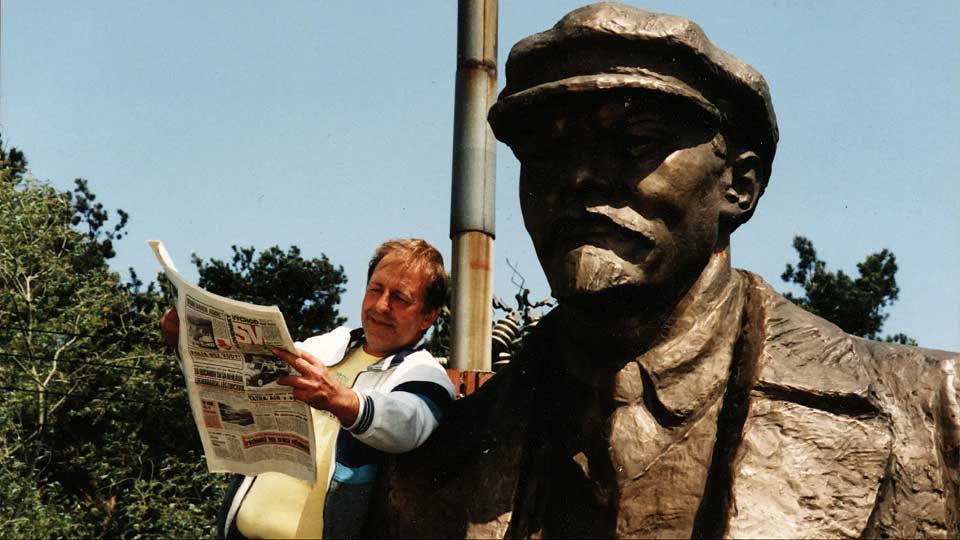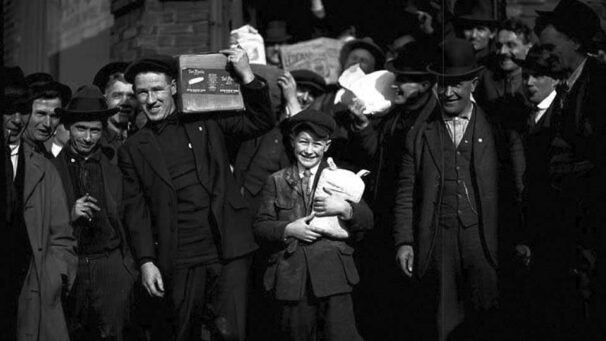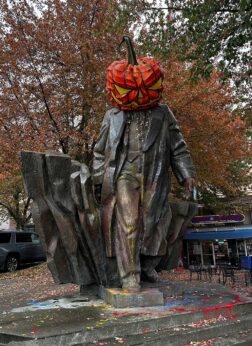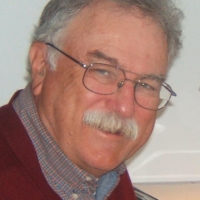
This article is part of the People’s World 100th Anniversary Series.
For the anniversary of the Russian Revolution of Nov. 7, 1917, People’s World pulled this article from our 1995 archives about the installation of a statue of V.I. Lenin in Seattle, Washington. In the article, former Editor-in-Chief Tim Wheeler tells the backstory of that sculpture and the history of Lenin’s influence on American workers and labor history in Washington State. The statue of Lenin referenced in this article still stands in Seattle, on the corner of 36th Street and Fremont Place, awaiting a buyer. It is priced at $300,000, for anyone interested.
Lenin in Seattle
By Tim Wheeler
People’s Weekly World – Nov. 4, 1995
During my visit to Seattle in August, I visited the seven-ton bronze statue of V.I. Lenin which stands at the edge of a parking lot in the Fremont section of town.
 It was placed there by the Fremont Arts Council and the Fremont Chamber of Commerce on behalf of its owners, the Lewis Carpenter family of Issaquah.
It was placed there by the Fremont Arts Council and the Fremont Chamber of Commerce on behalf of its owners, the Lewis Carpenter family of Issaquah.
Lewis Carpenter was teaching in Poprad, Slovakia, in 1993 as the counterrevolution was still sweeping the formerly socialist country of Czechoslovakia. In the town, he found the Lenin statue lying face down where it had been toppled. He was so impressed by sculptor Emil Venkov’s depiction of Lenin that he mortgaged his house and arranged for the statue to be shipped back to Issaquah. Carpenter died in 1994. His family has lent the statue for temporary display in hopes of selling it for $150,000 to someone who wants to display it permanently.
While I was there, a steady stream of curious visitors came to visit the statue, which shows Lenin striding boldly forward, a determined expression on his face, his eyes focused on the distant horizon. A plaque tells the story of the statue and also offers a biography of Lenin. He is praised for his role in leading the revolution that overthrew the Czarist autocracy and for ending the famine and mass illiteracy that blighted the lives of the Russian people.

A letter appeared in the Seattle Post-Intelligencer which asked why a statue of Lenin is displayed in Seattle. The answer lies in the hidden history of Lenin’s Letter to American Workers, as well as in the story of the Seattle General Strike of 1919.
Workers in Seattle, many of them members of the Industrial Workers of the World (IWW), were locked in a bloody struggle during and immediately after World War I. There was ruthless exploitation by shipyard owners, mining, and timber interests in the Pacific Northwest. Wages were frozen during the war, but costs rose 50% and corporate profits skyrocketed.
The employers and their government agents used World War I to whip up some of the bloodiest repression ever unleashed against the working class in the United States. The aim was to enforce the 12-hour workday and starvation wages. For example, Eugene V. Debs, a socialist and leader of the railroad strike, was sentenced to ten years in prison for a speech he delivered against World War I.
On Armistice Day 1919, American Legionnaires in the sawmill town of Centralia, Wash., staged a jingoistic march that turned into a riot. The mob descended on the IWW headquarters. Shot to death were IWW members Warren O. Grimm, Arthur McElfish, and Ben Casagranda. Wesley Everett was lynched.
All of them were union militants struggling to win a living wage and tolerable working conditions for the “bindlestiffs” – loggers who migrated from one logging camp to the next, their blanket, or “bindle,” wrapped across their shoulder. The class warfare gave birth to strong feelings of solidarity among U.S. workers with the revolutionary struggle of workers and peasants in Russia.
IWW “Wobblies” in Seattle wrote a letter to the Bolshevik leaders in Russia a few weeks after the 1917 revolution asking them to send someone to help answer the flood of government and media lies about their victory over Czarism and capitalism. The Bolsheviks responded by sending the Russian cargo ship Shilka, which arrived in Seattle on Dec. 21, 1917, the first Soviet ship to reach the United States.
Workers hurried from all over Seattle to greet the ship riding at anchor in Eliott Bay with the hammer and sickle banner flying. The Hearst-owned Post-Intelligencer ran screaming headlines that the Shilka had $100,000 in Kremlin gold in its hold to finance an IWW revolution. Police confined the crew aboard the ship and searched it. They found no gold, rifles, or dynamite. Labor was so strong in Seattle in those days that ruling circles were forced to relent. Shilka crew members came ashore and spoke at big, enthusiastic rallies.
IWW leaders conceived the idea of sending a letter, addressed to V.I. Lenin, the Bolshevik government, and the Russian working class, to be carried by Shilka crew member Nikolai Kryukov. Art Shields, who was in Seattle at the height of these struggles, reports in his autobiography, On the Battle Lines, that the letter was drafted by Roy Brown, a friend of Shields who later became national chairman of the IWW and then joined the Communist Party USA.
The letter expressed solidarity with the Russian Revolution and told of the bloody persecution of workers in the U.S. It was hidden inside a life preserver on the deck of the ship.
When the Shilka returned to Vladivostok, Kryukov delivered the letter to Bolshevik Party leaders who decided that it was so urgent that it should be published immediately. It was carried in two installments in the Vladivostok newspaper Krasnoye Znamya (Red Banner).
Four months later, Lenin replied in his famous Letter to American Workers. “We know that circumstances brought to the fore our Russian detachment of the socialist proletariat not by virtue of our merits but due to the particular backwardness of Russia,” Lenin wrote.

“Despite this, we are firmly convinced that we are invincible because mankind will not break down under the imperialist slaughter but will overcome it. And the first country which demolished the galley chains of imperialist war was our country…. The American people have a revolutionary tradition adopted by the best representatives of the American proletariat, who gave repeated expression of their solidarity with us, the Bolsheviks.”
Lenin hailed the U.S. revolution of the 1770s as “one of the great, really liberating, really revolutionary wars.” He spoke of the Civil War to end chattel slavery in the U.S. as an extension of that revolutionary process.
“I am not at all surprised that [President Woodrow] Wilson, the head of the American billionaires and servant of the capitalist sharks, has thrown Debs into prison,” he said. “The American workers will not follow the bourgeoisie…. The whole history of the world and the American labor movement strengthens my conviction.”
Lenin’s letter was smuggled back into the U.S. by Pyotr Travin, who delivered it to John Reed in New York City. Along with the letter, Lenin had appended a note addressed to President Wilson surging U.S. recognition of the infant Soviet republic. Reed arranged for Sen. Hiram Johnson, R-Calif., to read Lenin’s note on the U.S. Senate floor.
In his memoirs, Kryukov reports that, indeed, Lenin received the letter from Seattle. “I was elected delegate from Tomsk Gubernia to the Fifth All-Russian Trade Union Conference [in Nov. 1920],” he wrote. “The conference was attended by Lenin. During an interval, Grigory Yermolayev and I asked him if he was familiar with the letter from American workers which was brought from Seattle in the beginning of 1918. He replied that he had read the letter and sent an answer to the U.S. workers. ‘And why are you interested?’ he asked. We gave a brief account of the Shilka’s cruise. Lenin thanked us for delivering the letter.”

Lenin’s influence reached its zenith during the five-day Seattle General Strike of 1919. With the end of the war and the lifting of the strike ban, Seattle’s 30,000 shipyard workers were determined to win higher wages. In his remarkable book Revolution in Seattle, Harvey O’Connor, who was an eyewitness and participant in the struggles, described the militant fightback that was in Seattle’s damp air in the autumn of 1918.
The radical writer Anna Louise Strong had obtained a copy of an April 1918 speech by Lenin on the tasks of organizing “Soviet power.” She gained approval for its publication in the Union Record, the official publication of the Seattle AFL Central Labor Council.
Writes O’Connor, “Twenty thousand copies were published and avidly read by radicals up and down the Pacific coast as well as in Seattle’s shipyards. The extraordinary influence of this pamphlet was to be felt in subsequent events in Seattle as workers pondered the problem of ‘management’ in a workers’ state.”
Lenin’s ideas of grassroots worker and peasant democracy were put into effect when the general strike began a few months later in February 1919. An editorial in the Union Record, written by Strong, declared, “We do not need hysteria. We need the iron march of labor … Labor will feed the people … Labor will preserve order … Not the withdrawal of labor power, but the power of the strikers to manage will win this strike.”
Seattle was never so peaceful or well-managed before or since, O’Connor reports. On Thursday, Feb. 6, 1919, workers throughout the city downed tools and walked off their jobs. Silence reigned over the city. Labor Guards, identified by their white armbands, were on patrol but had little to do.
The strikers set up 35 “milk stations” to provide milk for families. Twenty-one cafeterias provided meals for 25 cents for union members and 35 cents for anyone else. The IWW “saw to it that the gin mills on the skid road were shut down,” O’Connor writes. There was “exhilaration” at the display of solidarity throughout the city.
But the strike, with its dramatic proof that workers could manage an entire city, struck fear into the ruling class. President Wilson sent army troops to occupy the city. Machine gun emplacements were set up. Yet even the soldiers had nothing to do.

After five days, the strikers voted to end their general strike, the first ever in the history of the U.S. The shipyard workers continued their battle and ultimately won significant improvements in wages and benefits.
A few weeks after the strike, the U.S. government attempted to smuggle 50 railroad carloads of rifles in boxes stamped “Sewing Machines” aboard the ship S.S. Delight bound for Vladivostok. They were to be delivered to Admiral Kolchak’s pro-Czarist counter-revolutionary army.
“But longshoremen were suspicious,” Art Shields writes. “They dropped a slingload of boxes on the dock and Remington rifles tumbled out… The longshore union declared that dock off limits to union men. Those rifles lay untouched on the docks for three weeks until conscripted troops were sent in to scab.”
It was too late. By the time the rifles reached Russia, the Red Army had defeated Kolchak’s army. Soviet power was to reign for another 70 years as the workers and farmers constructed the world’s first socialist state.
I grew up in the state of Washington and took the required 7th-grade course in Washington state history. We memorized the name of every county, but not a word was breathed about the general strike of 1919 – let alone V.I. Lenin’s influence on it. It was an event that Todd Shipyards, the Bremerton Naval Shipyard, Boeing, Weyerhaeuser, and Crown Zellerbach wanted forgotten.
Harvey O’Connor was a family friend who visited our farm, and I grew up hearing stories about the “Revolution in Seattle.” O’Connor described how James A. Farley, Franklin D. Roosevelt’s postmaster general, once proposed a humorous toast “to the 47 states and the Soviet of Washington.” If that statue of Lenin were placed permanently on Seattle’s waterfront, it would help the people of Washington State rediscover something heroic about their past.
CHECK OUT THESE RELATED ARTICLES:










